FC Nantes are an historical Club in France and were a dominant side in Ligue 1 a few decades ago. The club has won eight Ligue 1 titles, the most recent being in the 2000-2001 season, and only PSG, Marseille, and Saint-Étienne count more than the canaries. The 2019-2020 season wasn’t a particularly happy one for Nantes in terms of results, the team ended its league campaign in 13th place but only four points away from 5th place, leaving us all to wonder whether their finishing position could be a different one if the league was to continue.
Christian Gourcuff was the man in charge of Nantes this season, the French coach managed a very good start to the season with the team sitting in second place after ten games played and surprised everyone with his philosophy. Three consecutive losses and a draw followed this good period, and although the team managed to win more games, they never picked up on their good form.
In this tactical analysis, we’ll be taking a look at how FC Nantes played under Christian Gourcuff, an analysis of the team’s behaviour and tactics in the various phases of the game will allow us to identify their strengths and weaknesses as well as suggest ways in which they could improve.
System and formations
FC Nantes most used formations this season are the 4-4-2, 4-4-1-1 and 4-2-3-1. Despite the different formations, and as we’ll see further into this analysis, the positions of the players and the dynamics the team looked to impose were often the same. In all the formations we have the common factor of a player taking up the number 10 role and playing as an enganche, roaming around the final third to link-up the play between the midfield and the attacking players.
In the image below we can see Nantes’s formation based on the average positions taken by the players on the pitch, the image also highlights the most common passing lanes between players and gives us a general view of the way Nantes build their play.
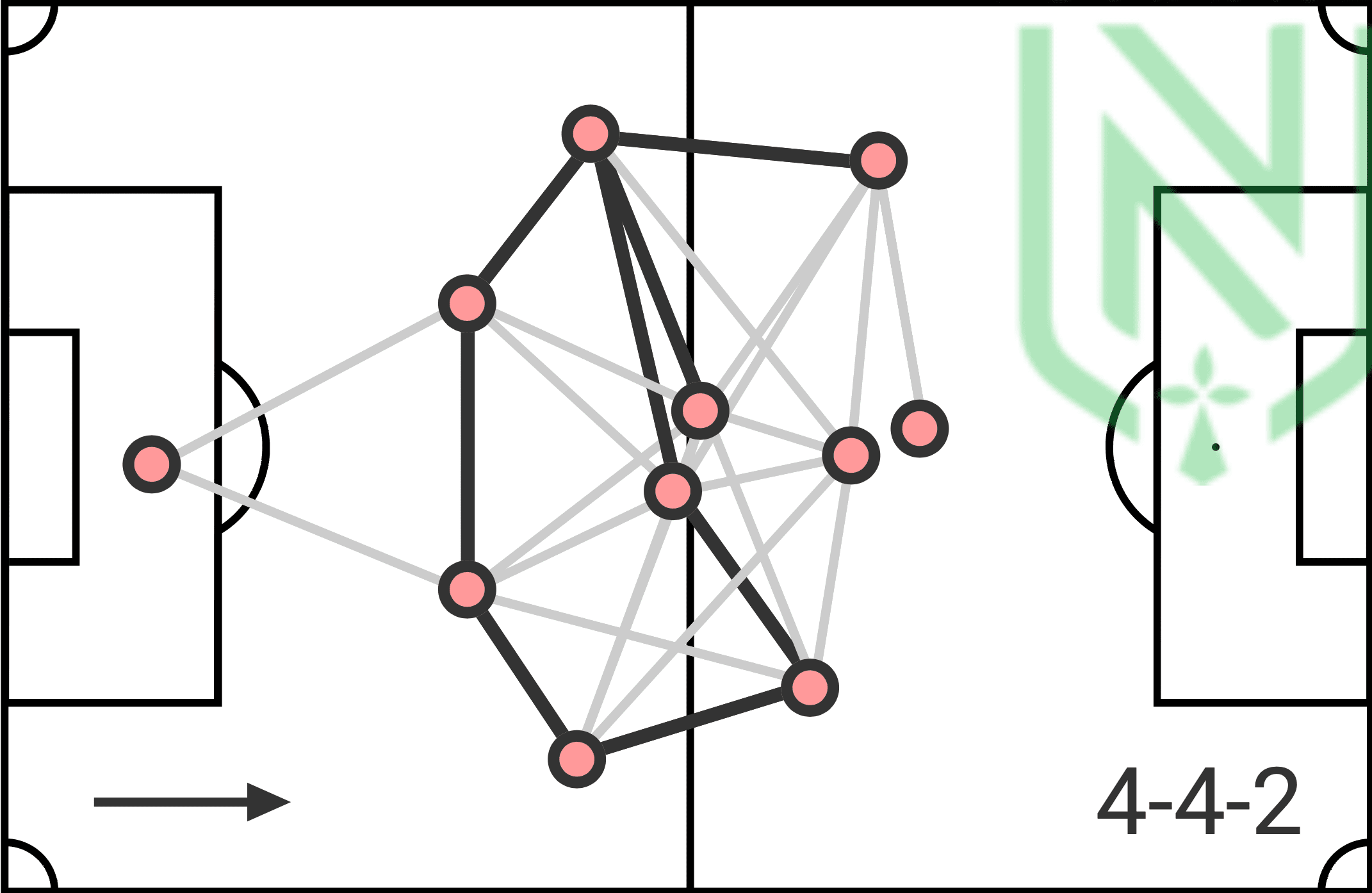
By looking at the image we can see that the team looks to build its play through the wide areas, that can be explained by many teams blocking the central areas with their defensive shape, not only that but because Nantes look to create wide overloads, the wide build-up suits their style of play.
The team’s style of play can be generally described as possession based football with a lot of verticality as well as positional fluidity. Nantes look to progress the ball up the pitch with passing combinations but they also aim to be as vertical as possible with those passes to get the ball fast into the final third.
Taking a look at the data will allow us to have a better picture of Nantes’s style of play. In the next image, we can see a graphic that shows the types of passes made by teams in Ligue 1. The aim of this graphic is to show which teams have a more positional approach to their play and which teams rely on a more direct approach. Lateral passes per 90 minutes and long passes per 90 minutes where the metrics plotted on both axes.
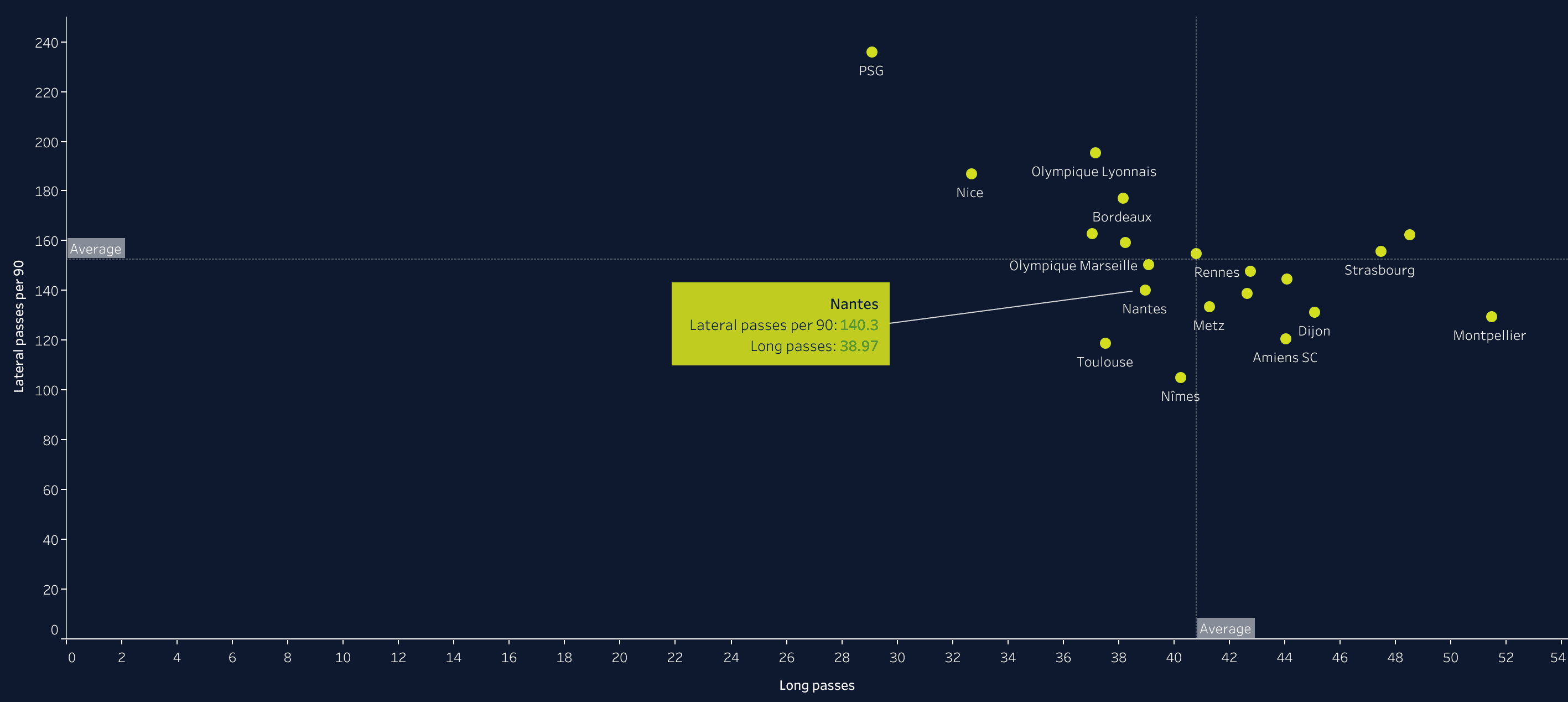
An analysis of the graphic shows us how Nantes fall under the category of teams who favour positional play falling below the league average when it comes to long passes. It is curious how the team also falls below average when it comes to lateral passes, this can be related to one of the mentions characteristics that are associated with the team’s style of play: focus on vertical play.
In this next graphic, we take a look at the percentage of forward passes in relation to the total average passes per 90 minutes made by each team. We also take a look at the number of progressive passes per 90 minutes made by each team, this way we can determine which teams play more vertical and progressive football.
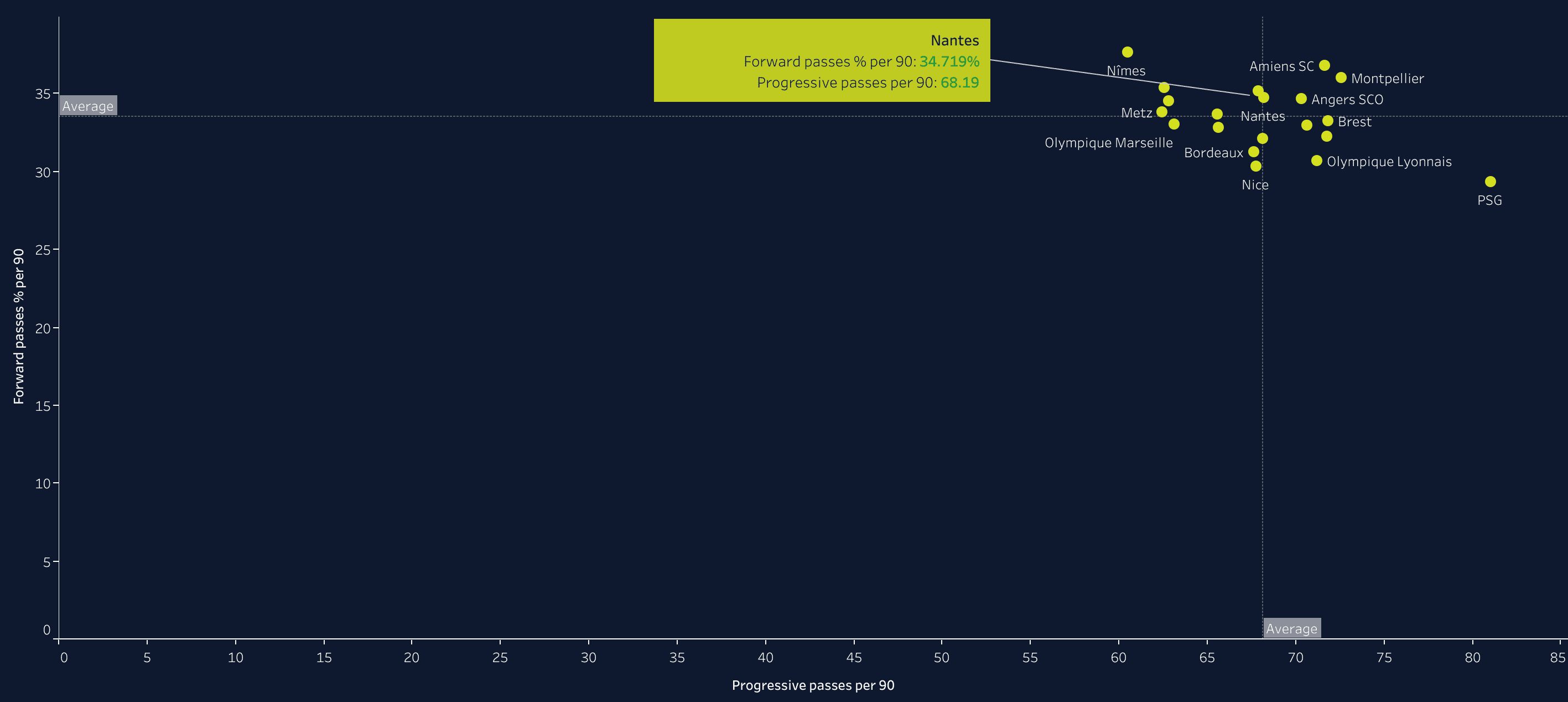
We can see how FC Nantes are above the league average when it comes to the percentage of forward passes in relation to their total passes per 90 minutes, and this does not mean that the team’s playing style is not based on positional play, just that their emphasis is on playing the ball forward and progressing up the pitch. Paris Saint-Germain are a possession based team that also relies on positional play, however, their style of play is not as vertical and they play a lot more lateral passes in order to break the opposition’s shape. Nantes fall just on the average line when it comes to progressive passes per 90, and that combined with the balance between the number of lateral passes (140.26) and forward passes (137.52) per 90 minutes, shows us how Nantes tries to play forward whenever they have the space, making just the needed amount of short lateral passes to find that space.
Offensive Organisation
Build-up Phase
Nantes like to start building their play from the back with short passes, for that they usually have their two centre-backs spread apart to receive the ball from the goalkeeper forming the first line of two men. The full-backs will stay wide and move a bit higher up the pitch to stretch the opposition’s first line of press and one of the midfielders will provide a passing lane behind that line. The shape will look like a 4-3-3 with the winger on the ball side moving a bit more centrally and the second striker/ number 10 joining the build-up in those areas to create numerical superiority. Nantes will try to build their play through the wide areas using that same superiority.
In the image below we have a clear picture of the team’s shape and relations in the first build-up phase. Notice how the midfielder on the far side is dropping deep to provide cover on the space left open by his midfield partner that’s joining the build-up. Nantes’s midfield changes from a double pivot to a single pivot in the build-up phase, this allows the team to have more players to receive the ball in advanced areas, however, if the team needs covering or another passing lane, the midfielder who moved up will drop deep to provide that.
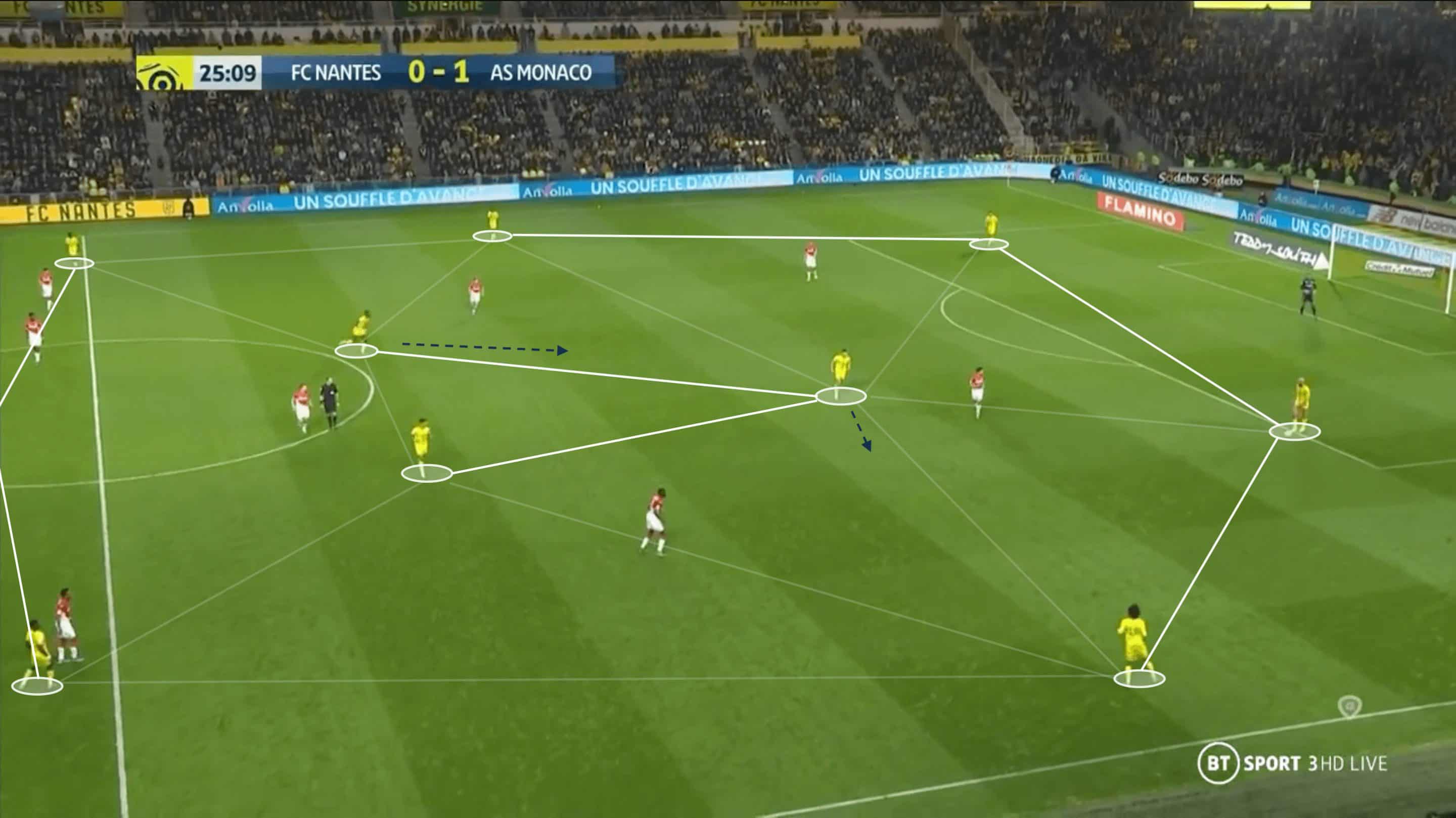
The goal is to take advantage of the numerical and zonal superiority to progress up the pitch as fast as possible, Nantes uses quick passing combinations between the players creating that overload to achieve that effect. If they are not able to be vertical and progressive with the play through the opposition’s press in one side, they will try and quickly change the play to the other side to attempt the same.
When Nantes are in their 2nd build-up phase, ie. , before they get to the final third, they can have up to six players near the wide areas to create numerical superiority so that they can progress up the pitch with more ease. One of the midfielders occupies what would be the position of the full-back and acts as the lower vertex of the players, allowing the full-back to go up. The other midfielder will position himself a bit more centrally so that he can switch the play to the other side if necessary, or play through the centre. The winger will pin the opposition’s full-back, and the striker will do the same with the centre-back, with the second striker/number 10 searching for any available space to receive the ball.
In the image below we can see a very good example of the mentioned positions and dynamics that Nantes deploy in their 2nd build-up phase.
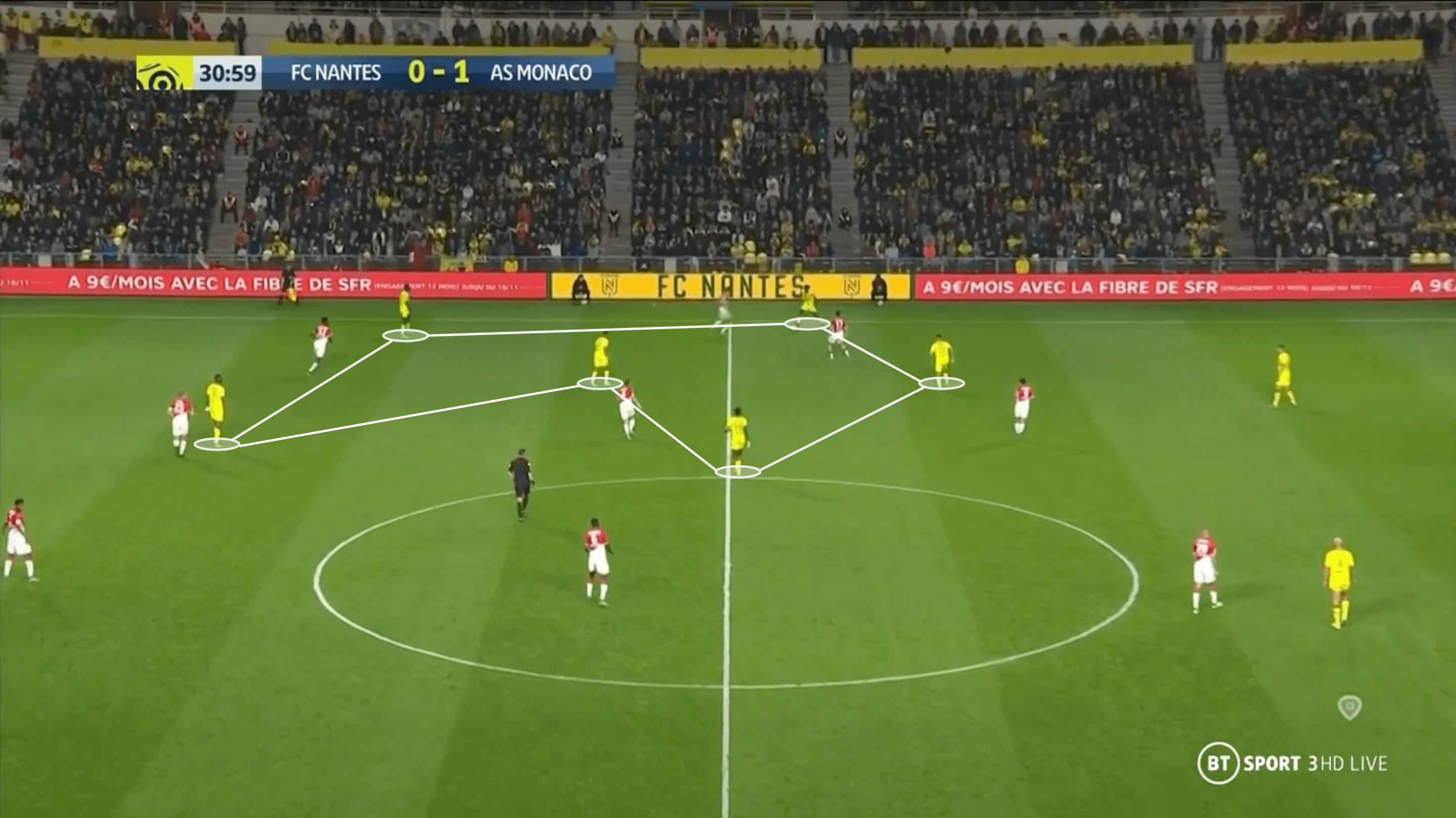
If Nantes are unable to play out from the back they resort to a long ball to their striker with players positioned around him in order to win the second ball.
It is worth mentioning that Nantes are not flawless when building their play form the back. We can notice how the team has clearly defined principles and movements Gourcuff wants his players to make, however, the build-up process is not always smooth and sometimes the players end up having to resort to long balls behind the opposition’s defensive line. This type of situations happens because of bad positioning, as well as some missed passes and first-touches that ultimately don’t allow the process to run smoothly and the team to progress with sustained possession play.
In the final third
When Nantes are able to get to the final third having created that wide overload they will try to attack the opposition’s goal by taking advantage of that numerical and zonal superiority. The players in that area play passes between to either find the space in behind the opposition’s defensive line using the third man concept or, get the ball into more central areas where they can access the opposition’s penalty box with more ease. Nantes averaged 14.19 touches in the penalty area per 90 minutes this season, which ranks them 7th in the league in this chapter.
The role of the second striker/number 10 in this manoeuvre is pivotal for the team as he is supposed to be the element that provides Nantes with the extra man in all areas of the pitch. This player will play as an enganche and has the freedom to roam around the pitch trying to find spaces to exploit or providing passing lanes for his teammates. He can appear in wide areas to attempt short one-two combinations with his teammates to access the opposition’s penalty area, he can drop deep to help the team progress the ball up the pitch, or even make third man runs in behind the opposition’s defensive line himself, getting into dangerous positions to provide assists or score goals.
In the image below we can see Nantes’s wide overload working. The player’s interchange passes between them until one makes the third man run, in this case, Cristian Benavente who was playing in that enganche role was the one attacking depth through the half-space. Ludovic Blas plays the ball to the Peruvian making the third man run, and Benavente gets near the touchline before playing the ball back to the Frenchman who followed his movement with a run into the box. The play ended up in a goal.

If Nantes are unable to profit from their wide overload they always have an alternative ready. Nantes’s wingers are all very fast players who can be very dangerous in 1vs1 situations. This characteristics from the wingers can be useful in a variety of ways, for example, to make that already mentioned third man run and exploit space or maybe get past a direct opponent and cross the ball, but Nantes use a clever strategy to maximise the impact their fast and unpredictable wingers can have.
When the team has possession and creates a wide overload in one side of the pitch, the winger on the far side will stay very wide near the touchline providing full width. This allows Nantes to always have the option to quickly switch the play to the other side and because they attract the opposition to one side with the wide overload, the wingers are often isolated and in 1vs1 situations. This can be very dangerous for the opposition because both Moses Simon and Jonathan Bamba are two very fast wingers who can easily beat their man in a 1vs1 situation and get into positions where they have the time and the space to decide what they want to do: shoot, pass or cross the ball to his teammates making runs into the penalty area from the far side.
Nantes took good advantage of this 1vs1 situations this season, in fact, they averaged 30.32 dribbles per 90 minutes this season with a 49% success rate making the 3rd best team in this chapter.
In the image below we can see one of the mentioned situations. Notice how Nantes attracted almost every Monaco player to one side of the pitch, meanwhile, Mose Simon and Fabio are providing width on the far side and a quick change of play form Touré puts Monaco’s wing-back on a very difficult 2vs1 situation.
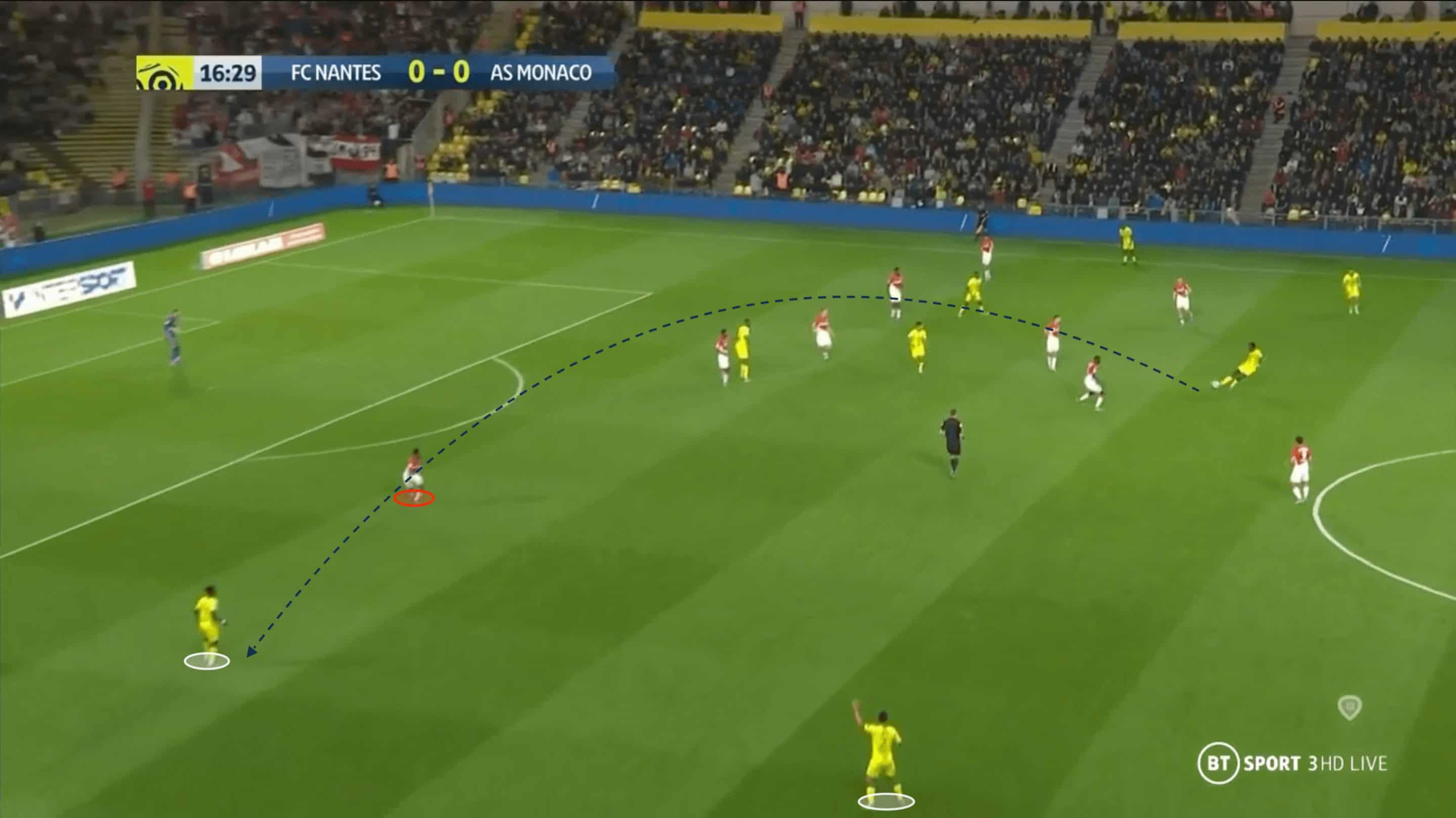
Defensive Organisation
Nantes’s position themselves in narrow 4-4-2 shape when defending and present a mid-block. The goal with this shape is to take away the central spaces from the opposition so that they are forced to build their play though the wide channels. The first line of two men will press the opposition’s centre-backs if they try to build their play from the back, with one of the midfielders joining that press if the opposition have a first line of three-man starting their build-up. Nantes don’t always adopt this man to man approach and high pressing on the opposition’s first build-up phase, if they feel that the opposition are a team that can hurt them through the middle, they will only press with the two men up front. This defensive formation was well executed throughout the season by Nantes, the team conceded 31 goals in the league making them the 7th best defence.
In the image below we can see an example of Nantes’s 4-4-2 defensive shape and pressing movements.
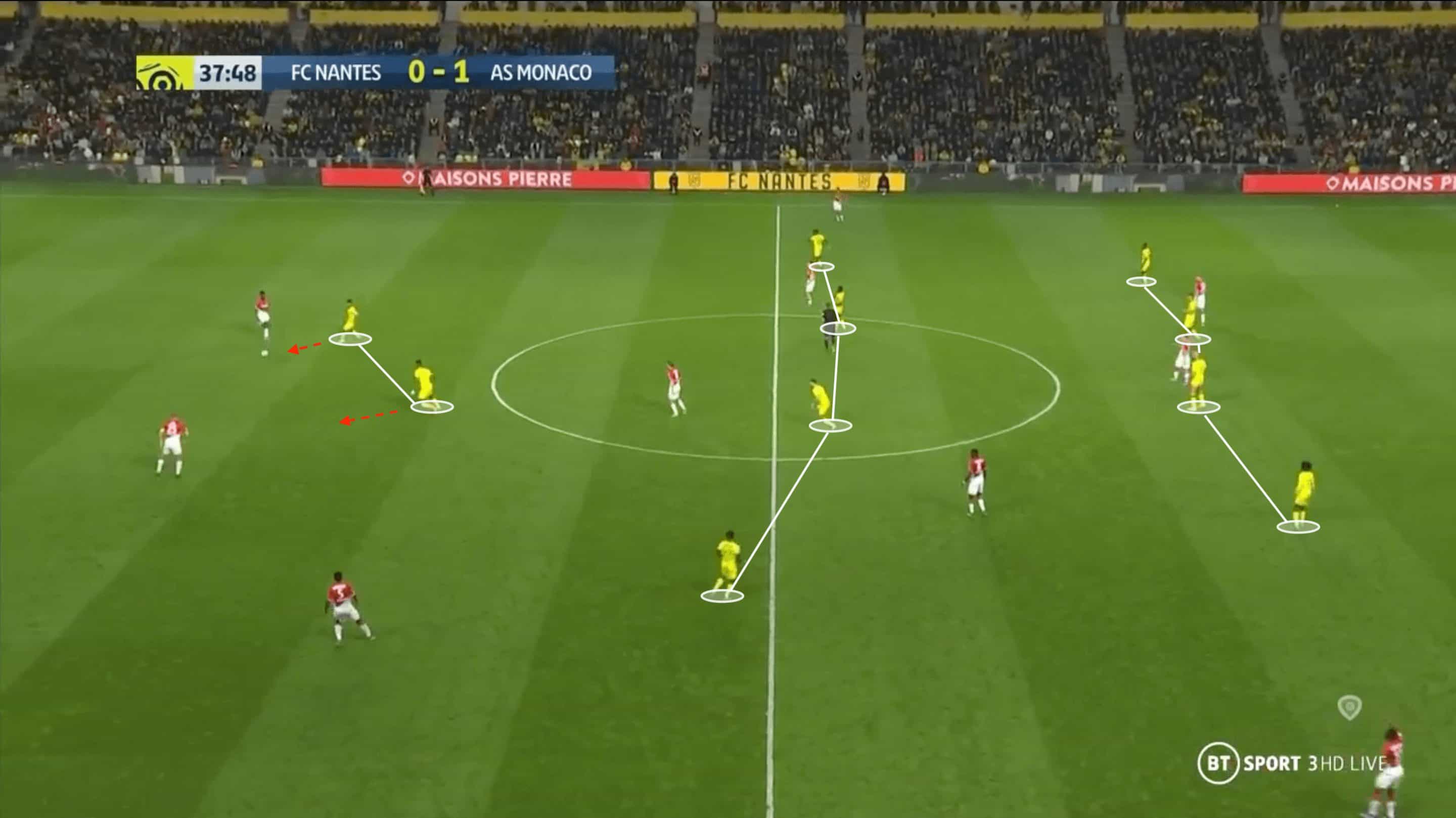
When Nantes are successful in forcing the opposition to play the ball wide, the pressing trigger for the players on that side is activated. The striker, winger, and midfielder on the ball side will press and cut off the passing planes for the player on the ball, this way Nantes are able to keep their shape while also having a chance of taking the ball from their opponents. This pressing trap can be particularly useful if the players performing it are able to cover the passing lanes available to the player on the ball, leaving him with little options but to play a long ball and possibly forcing a mistake.
In the image below we can see Nantes trapping Jemerson who is on the ball as soon as the pass is played into him. The Brazilian has the support of Bakayoko but they are outnumbered against three Nantes players, as a result, he is forced to play the ball long and Nantes’ defensive line is able to recover it.
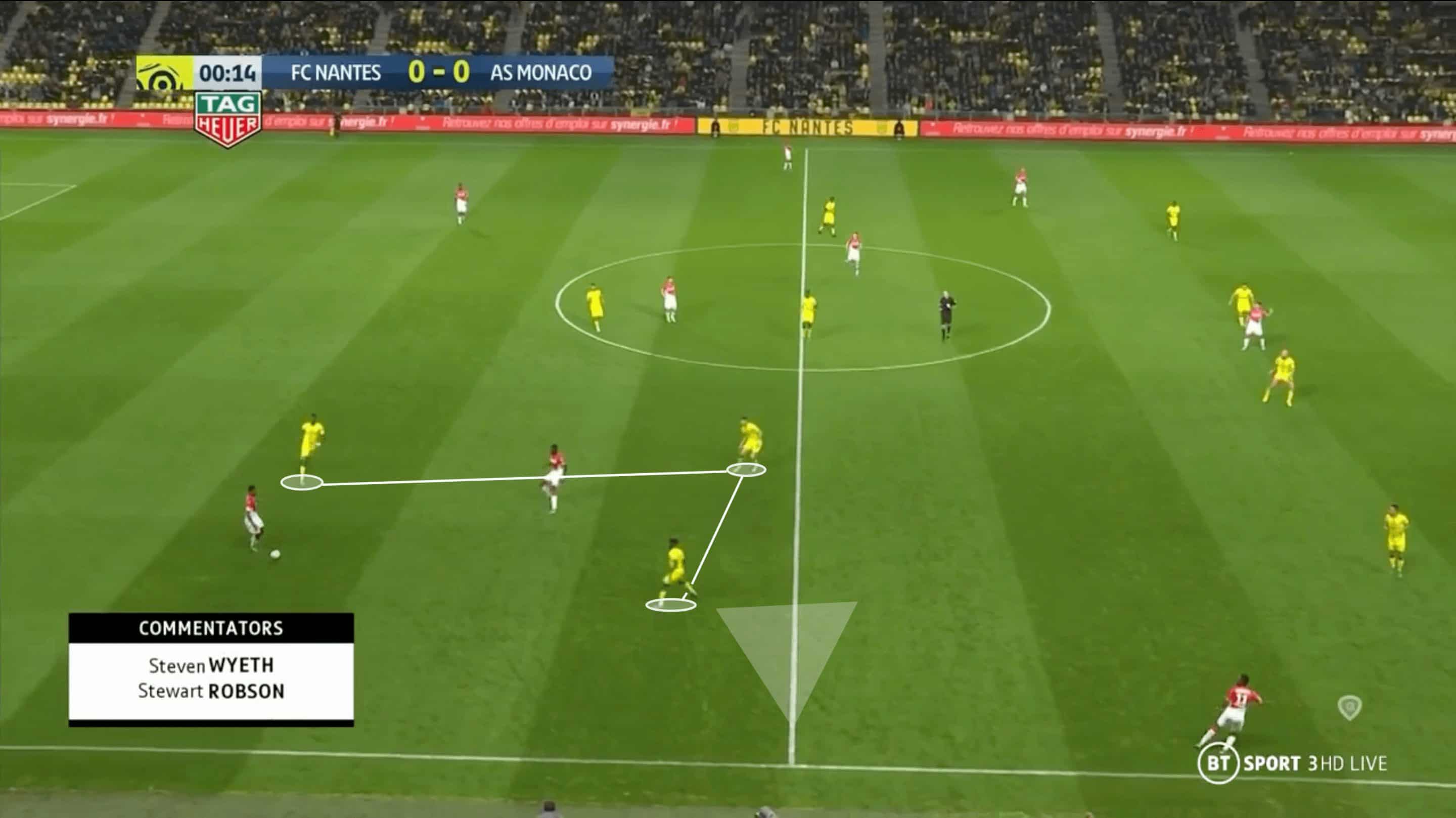
Offensive Transition
When Nantes are able to recover possession they look to counter-attack and take advantage of the fast players they have in the team. As soon as a player wins the ball back and there is space to progress, other players will make runs forward and try to make themselves viable passing lanes so that the team can counter. Because of their 4-4-2 defensive shape, Nantes usually have two players ready for the counter-attack, the striker and the enganche, but the wingers will often make runs forward if they spot the chance for the counter. Nantes can be quite deadly in these situations as they have fast players who are also very good on 1vs1 situations and players like Ludovic Blas or Louza who can play killer passes in behind the opposition’s defensive line.
The image below shows a good example of how Nantes tries to counter-attack if the chance arises. The ball is recovered in the midfield area and immediately players start running forward and trying to make themselves available to receive the ball.
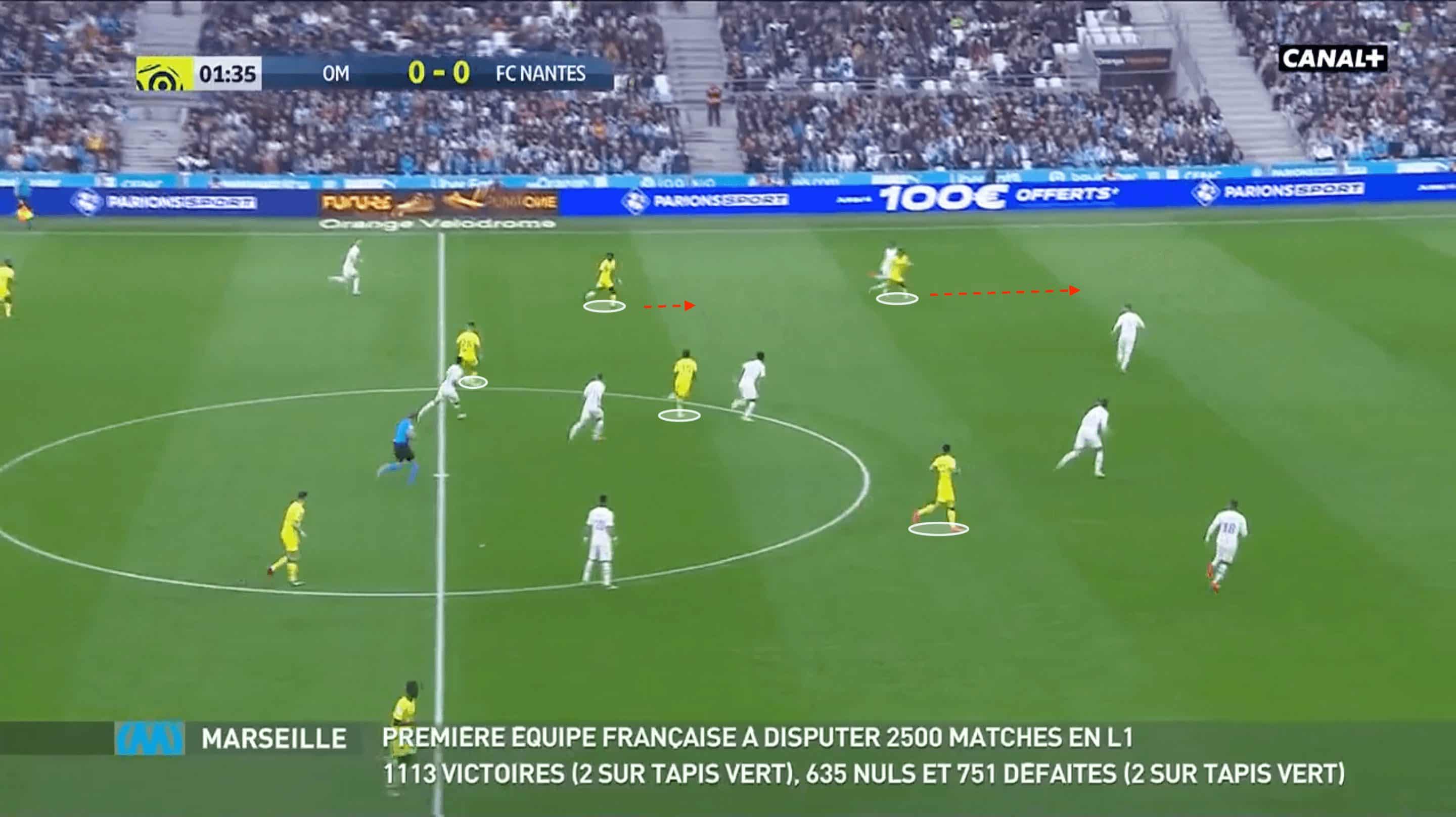
Defensive Transition
FC Nantes’s reaction to losing possession is to counter-press to try and win the ball back fast. The players that are near the ball will collapse on the opponent who has it in an attempt to regain possession with their press while the rest of the team regroups back into shape. This often corresponds to 2/3 players performing this counter-press, if they are not able to get the ball back quickly, they will also return to their positions within Nantes’s 4-4-2 defensive shape.
The defensive transition is probably the moment of the game Nantes need tho improve the most. The players often react late and that ends in the counter-press not being effective, moreover, this means that if the opposition is able to surpass that first press they will have more spaces to exploit due to the pressing players being out of position. Nantes’ pressing intensity value (PPDA) reflects what was said, the team allows 11.54 passes to the opposition before a defensive action is made, and that is because players are often late to react and press the opponents.
In the image below we can see three Nantes’ players counter-pressing after they have lost possession. Their pressing is late and ineffective allowing Marseille’s players to escape it and counter-attack.
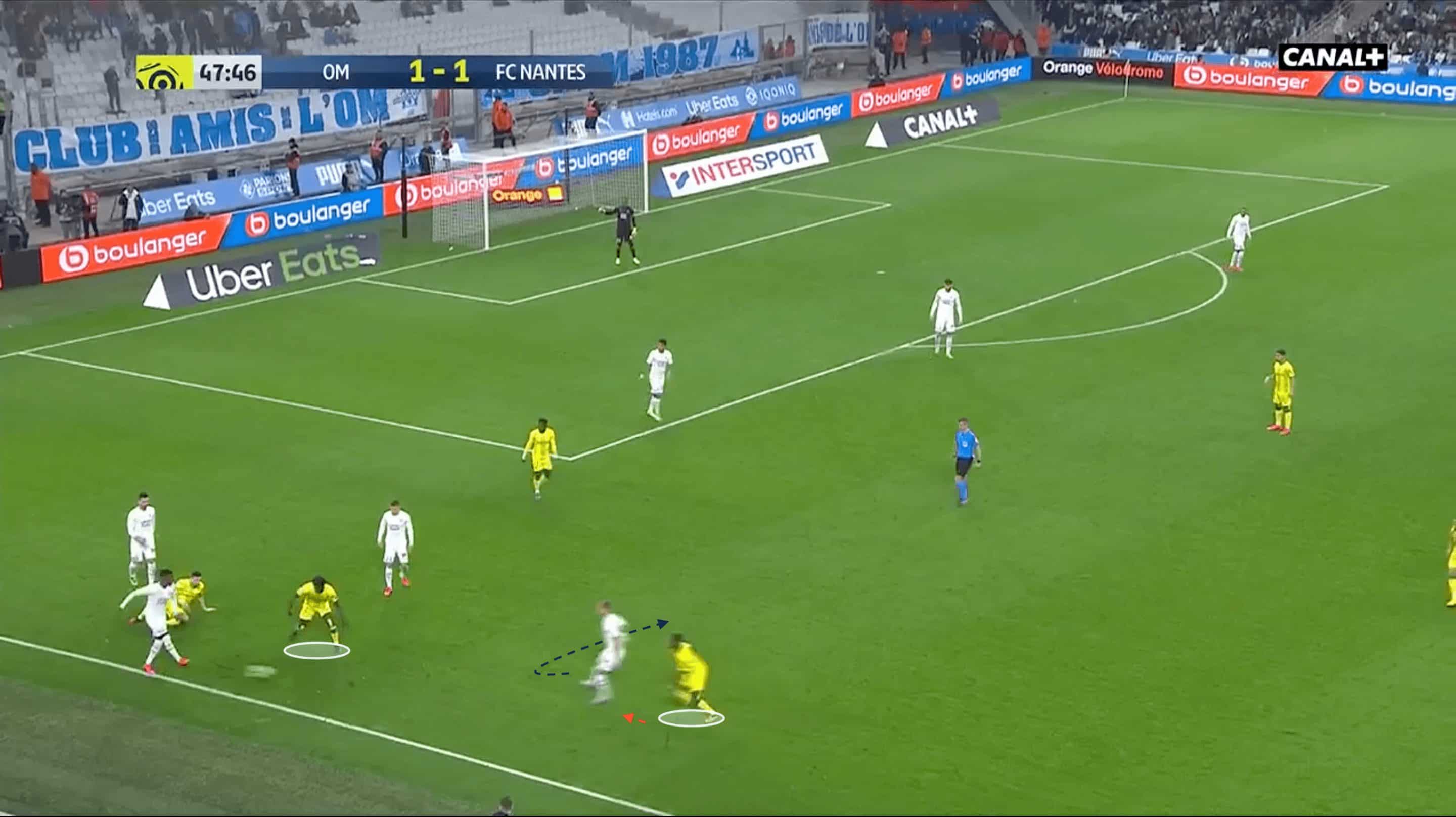
Conclusion
This tactical analysis showed how Nantes are a well drilled team that flashed some very good signs at the beginning of the season, they were able to maintain themselves in a UEFA Champions League spot for 10 rounds but, after three losses in a row, they never seemed to get back into good form.
Christian Gourcuff was able to assemble a team that plays an enjoyable brand of football, with a lot of passing combination and positional interchanges in the wide areas, as well as a great ability to isolate wingers in 1vs1 situations. The team created a good amount of chances using those combinations but were unable to profit enough from them, scoring only 28 goals in the league.
Lastly, Nantes definitely need some improvement when it comes to their defensive transition, as their counter-pressing proved to be unsuccessful quite often and allowed opponents to exploit the spaces left open in their defensive shape. If Nantes improve their goalscoring record and pressing intensity, and maintain their good chemistry, tactics, and enjoyable style of play, they might just be in the race for a European spot next season.

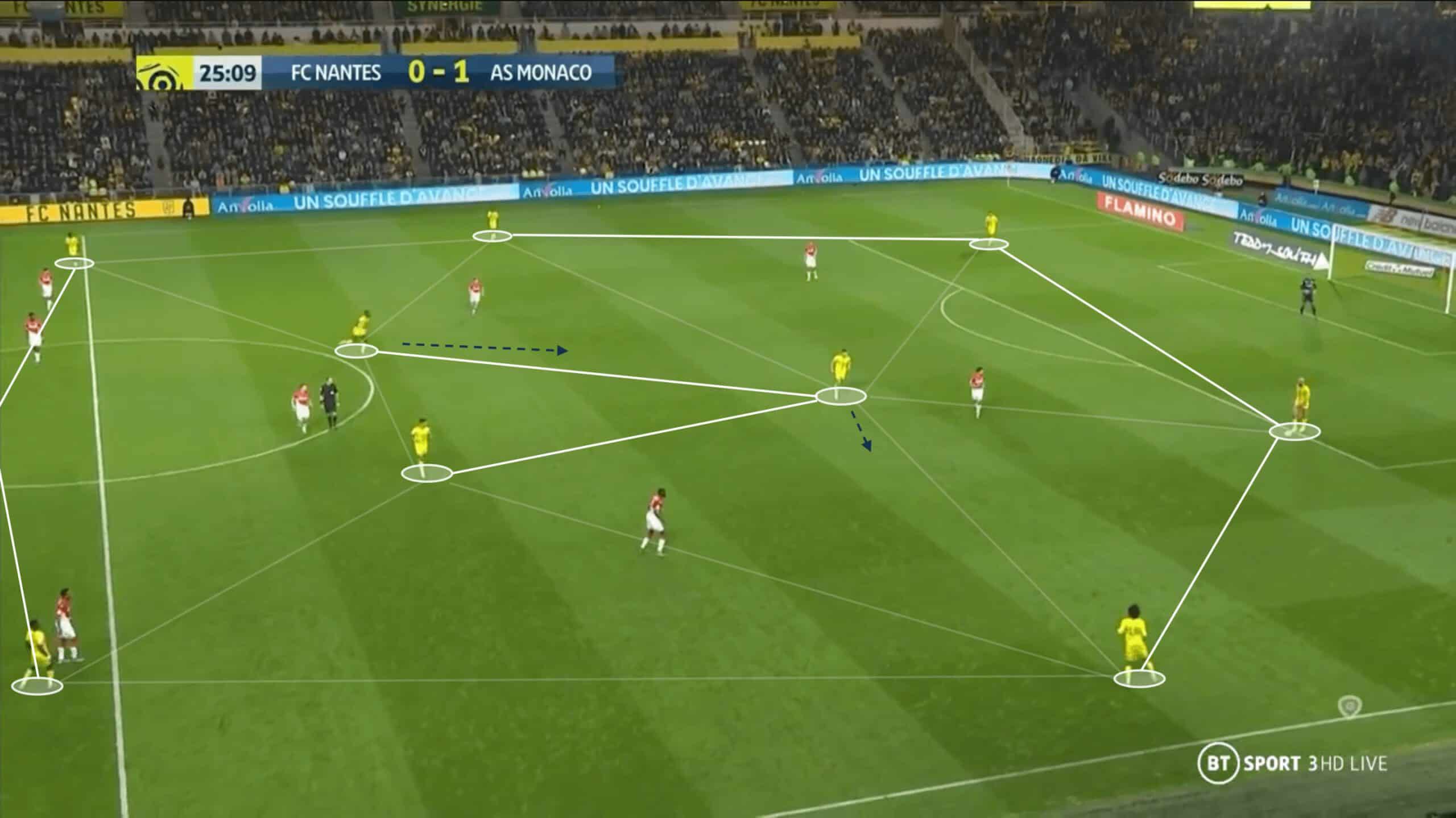



Comments